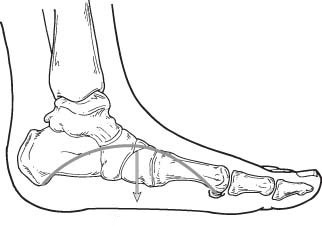Causes
Most people who develop Adult Acquired Flat Foot already had flat feet. A change occurs in one foot where the arch begins to flatten more than before, with pain and swelling developing on the inside of the ankle. Why this event occurs in some people (female more than male) and only in one foot remains poorly understood. Contributing factors increasing the risk of adult acquired flatfoot are diabetes, hypertension, and obesity.
There are some medical conditions, for example rheumatoid arthritis, which can have patients predisposed to inflammation of the tendon or arthritis of the major joints of the rear foot which can result in adult acquired flat foot.
Diagnosis
The Adult Acquired Flat Foot, secondary to Posterior Tibialis Tendon Dysfunction, is diagnosed in a number of ways with no single test proven to be totally reliable
Observation of the foot in a walking examination is most reliable. The affected foot appears more medially deviated at the subtalar joint and deformed compared to the unaffected foot. Muscle testing will show a strength deficit. An easy test to perform in the office is the single foot raise.
A patient is asked to step with full body weight on the symptomatic foot, keeping the unaffected foot off the ground. The patient is then instructed to "raise up on the tip toes" of the affected foot. If the posterior tibial tendon has been attenuated or ruptured, the patient will be unable to lift the heel off the floor and rise onto the toes. In less severe cases, the patient will be able to rise on the toes, but the heel will not be noted to invert as it normally does when we rise onto the toes.
X-rays can be helpful but are not diagnostic of the adult acquired flatfoot. Magnetic Resonance Imaging (MRI) can show tendon injury and inflammation. Ultrasound can also be used. Normally diagnostic imagery is not necessary for a diagnosis.
Treatment
The adult acquired flatfoot is best treated early. There is no recommended home treatment other than the general avoidance of prolonged weight-bearing in non-supportive footwear until the patient can be seen in the office of the foot and ankle specialist.
In the early stages, the inflammation and tendon injury will respond to rest, protected ambulation in a cast, as well as anti-inflammatory therapy. Follow-up treatment with custom-molded foot orthoses and properly designed athletic or orthopedic footwear are critical to maintain stability of the foot and ankle after initial symptoms have been calmed.
An ankle foot orthoses known as the Richie Brace, has proven to show significant success in treating later stage posterior tibial dysfunction and the adult acquired flatfoot. This is a sport-style brace connected to a custom corrected foot orthotic device that fits well into most forms of lace-up footwear, including athletic shoes. The brace is light weight and far more cosmetically appealing than the traditional ankle foot orthoses previously prescribed.
What can Firefly do to help?
At Firefly we can advise a number of options to relieve your symptoms. This can include advice on: 
- proper footwear
- exercises to maintain muscle flexibility
- application of pads over any prominent deformities
- consider prescribing orthotics
- custom made foot orthotics
- consider a period of immobilisation
- advise on surgery
Will orthotics cure the problem?
In many cases, the conservative treatments are sufficient to resolve the symptoms and prevent tendon damage. However, they will not correct the foot position and there will always be the risk of further problems, especially in more severe cases.

